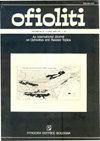provenÇal域早白垩世热液白云化U-pb定年及地球化学约束(意大利北部-法国东南部)
IF 1.3
4区 地球科学
Q2 GEOLOGY
引用次数: 1
摘要
在海上阿尔卑斯山脉(意大利西北部-法国东南部),普罗旺斯地区的中三叠纪Berriasian地台碳酸盐岩受到强烈热液白云石化的局部影响。这种白云石化作用是由与深层断层有关的大规模热液循环引起的,是阿尔卑斯-特提斯-欧洲古边缘这一地区白垩纪早期断裂活动的间接证据。新的碳酸盐U-Pb定年和地球化学(包裹体水上的稳定同位素和稀有气体,87Sr/86Sr,块状同位素)数据使我们能够更好地了解热液循环的时间和机制。热液可能起源于海水,海水参与了下伏结晶基底内的深层循环,经过加热至200°C以上,并通过与基底岩石的长期相互作用进行了实质性的成分改变。富含碳质物质的薄水泥边缘,局部与热液白云石胶结物交替,被解释为短暂微生物群落的残余物,这些微生物群落可能在热流体流量减少和同期海水向下渗透期间定居在热液管道的上部。本文章由计算机程序翻译,如有差异,请以英文原文为准。
U-PB DATING AND GEOCHEMICAL CONSTRAINTS TO EARLY CRETACEOUS HYDROTHERMAL DOLOMITIZATION IN THE PROVENÇAL DOMAIN (MARITIME ALPS, NW ITALY - SE FRANCE)
In the Maritime Alps (NW Italy - SE France), the Middle Triassic-Berriasian platform carbonates of the Provencal Domain are locally affected by an intense hydrothermal dolomitization. This dolomitization resulted from a large-scale hydrothermal circulation related to deep-rooted faults, and is indirect evidence of a significant earliest Cretaceous fault activity in this part of the Alpine Tethys European palaeomargin. New carbonate U-Pb dating and geochemical (stable isotope and noble gases on inclusion-hosted water, 87Sr/86Sr, clumped isotopes) data allowed a better understanding of the timing and mechanisms of the hydrothermal circulation. Hydrothermal fluids probably originated from seawater, which was involved in a deep circulation within the underlying crystalline basement, undergoing heating to more than 200°C and substantial compositional modification by prolonged interaction with basement rocks. Thin cement rims rich in carbonaceous material, locally alternated with hydrothermal dolomite cements, are interpreted as remnants of ephemeral microbial communities that could colonize the upper part of hydrothermal conduits during periods of reduced hot fluid flow and contemporaneous downward seawater infiltration.
求助全文
通过发布文献求助,成功后即可免费获取论文全文。
去求助
来源期刊

Ofioliti
地学-地质学
CiteScore
2.40
自引率
7.70%
发文量
1
期刊介绍:
Since 1976, Ofioliti provides an international forum for original contributions and reviews in the field of the geodynamics, petrology, geochemistry, biostratigraphy, stratigraphy, tectonics and paleogeography applied to ophiolitic terrains and modern oceanic lithosphere, including their sedimentary cover. Studies of topics such as geodynamics of the mantle, the evolution of orogens including ophiolites and paleoceanography are also welcome
 求助内容:
求助内容: 应助结果提醒方式:
应助结果提醒方式:


